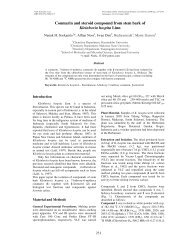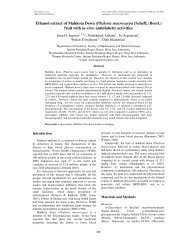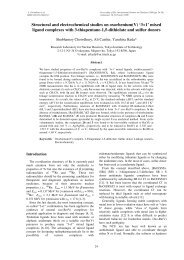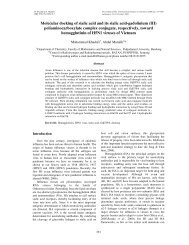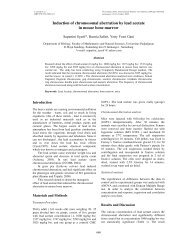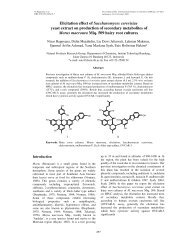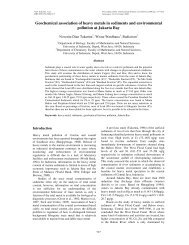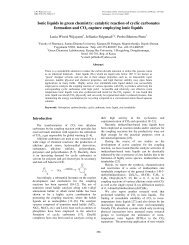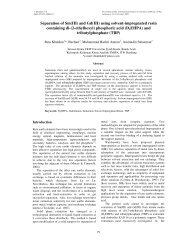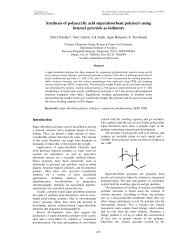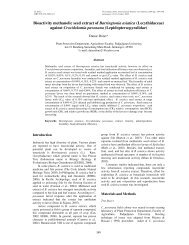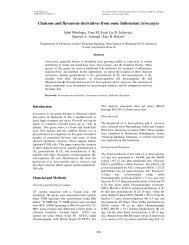Determination of inorganic anions in red algae (Eucheuma cottonii ...
Determination of inorganic anions in red algae (Eucheuma cottonii ...
Determination of inorganic anions in red algae (Eucheuma cottonii ...
- No tags were found...
Create successful ePaper yourself
Turn your PDF publications into a flip-book with our unique Google optimized e-Paper software.
R. Suhaili et al. Proceed<strong>in</strong>g <strong>of</strong> The International Sem<strong>in</strong>ar on Chemistry 2008 (pp. 406-410)ISBN 978-979-18962-0-7Jat<strong>in</strong>angor, 30-31 October 2008<strong>Determ<strong>in</strong>ation</strong> <strong>of</strong> <strong><strong>in</strong>organic</strong> <strong>anions</strong> <strong>in</strong> <strong>red</strong> <strong>algae</strong> (<strong>Eucheuma</strong> <strong>cottonii</strong>) andcarrageenan by suppressor system <strong>of</strong> ion chromatographyRefilda Suhaili 1 *, Edison Munaf 1 , Rahmiana Ze<strong>in</strong> 1 , Abdi Dharma 1 ,Anang Sedyohutomo 2 , Lim Lee Wah 2 , Toyohide Takeuchi 21 Department <strong>of</strong> Chemistry, Faculty <strong>of</strong> Mathematics and Natural Sciences,Andalas University, Padang 25163, Indonesia2 Department <strong>of</strong> Chemistry, Faculty <strong>of</strong> Eng<strong>in</strong>eer<strong>in</strong>g, Gifu University,1-1 Yanagido, Gifu, 501-1193, Japan*e-mail: refilda_59@yahoo.com; Phone: +81-26-628-806Abstract<strong>Determ<strong>in</strong>ation</strong> <strong>of</strong> <strong><strong>in</strong>organic</strong> <strong>anions</strong> <strong>in</strong> <strong>red</strong> <strong>algae</strong> (<strong>Eucheuma</strong> <strong>cottonii</strong>) and carrageenan by us<strong>in</strong>g two 6-port switch<strong>in</strong>g valves and two packed column suppressors system <strong>of</strong> ion chromatography was<strong>in</strong>vestigated. Sodium carbonate-bicarbonate as a mobile phase to <strong>red</strong>uce the background conductivityand to <strong>in</strong>crease the analyte signal was ma<strong>in</strong>ta<strong>in</strong>ed at low detection limits. The relative standarddeviations (RSDs) for the retention time, peak area and peak height <strong>of</strong> eight common <strong><strong>in</strong>organic</strong><strong>anions</strong> (0.3 mM each <strong>of</strong> F - , Cl - , NO 2 - , Br - , NO 3 - , HPO 4 2- , SO 42-and I - ) were between 0.0-0.2, 0.1-0.4and 0.1-0.3%, respectively. Inorganic <strong>anions</strong> conta<strong>in</strong>ed <strong>in</strong> <strong>red</strong> <strong>algae</strong> (<strong>Eucheuma</strong> <strong>cottonii</strong>) andcarrageenan shown <strong>in</strong> table.Table Inorganic <strong>anions</strong> conta<strong>in</strong>ed <strong>in</strong> <strong>red</strong> <strong>algae</strong> (<strong>Eucheuma</strong> <strong>cottonii</strong>) and carrageenanSampleF - Cl - NO 2-Anion conta<strong>in</strong>ed mg/100gBr - NO 3-HPO 42-SO 42-PureCarrageenan 1.75 16.60 1.28 5.22 445.47 8.64 19.16 11.66ExtractedCarrageenan 1.80 17.79 0.89 5.10 442.45 8.02 25.14 10.13<strong>Eucheuma</strong><strong>cottonii</strong> 2.33 10.02 1.71 7.77 448.94 7.99 22.14 15.12I -Keywords: Common <strong><strong>in</strong>organic</strong> <strong>anions</strong>, ion chromatography, packed column suppressor, <strong>red</strong> <strong>algae</strong>(<strong>Eucheuma</strong> <strong>cottonii</strong>), carrageenan, six-port switch<strong>in</strong>g valveIntroductionThe oceans cover 71% <strong>of</strong> the earth’s surface and<strong>in</strong>clude an abundance <strong>of</strong> fauna and flora. Thechemical composition <strong>of</strong> sea water is quite constant.but the nutrient levels for the plants <strong>in</strong> sea water areextremely variable and concentrations for some traceelements and vitam<strong>in</strong>s are more variable.Red <strong>algae</strong> (<strong>Eucheuma</strong>) is harvested throughout theworld as a food sources as well as an exportcommodity for the production <strong>of</strong> agar andcarrageenan products). F - , Cl - , NO 2 - , Br - , NO 3 - ,HPO 4 2- , SO 42-and I - are m<strong>in</strong>or essential nutrients <strong>in</strong>food that can lead to health dieses. The ions are an<strong>in</strong>dicator <strong>of</strong> the food quality [1]S<strong>in</strong>ce its <strong>in</strong>troduction <strong>in</strong> 1975, high performanceliquid chromatography (HPLC) is a ma<strong>in</strong> tool toseparate and determ<strong>in</strong>e <strong><strong>in</strong>organic</strong> cations and <strong>anions</strong><strong>in</strong> food. Many advances <strong>in</strong> ion chromatographic (IC)separation and detection have been reported. Thema<strong>in</strong> goal <strong>of</strong> ion chromatography (IC) as an analyticaltechnique is to provide complete <strong>in</strong>formation aboutthe ionic composition <strong>of</strong> the analyzed sample. Forobvious reasons, it is <strong>of</strong>ten necessary to use twodifferent sets <strong>of</strong> IC conditions for the separation anddeterm<strong>in</strong>ation <strong>of</strong> cationic and anionic species.Some <strong>of</strong> these are described <strong>in</strong> several books andpapers [2-6]. Some <strong>of</strong> the most important advancesrelate to suppressor development [4-8]. Recentdevelopments <strong>in</strong> conductivity suppressor technologyhave been reported for <strong><strong>in</strong>organic</strong> ion analysis by ionchromatography [5-10]. Packed-column suppressorssuffers from a number <strong>of</strong> disadvantages, <strong>in</strong>volv<strong>in</strong>g theneed for <strong>of</strong>f-l<strong>in</strong>e regeneration, band-broaden<strong>in</strong>goccurr<strong>in</strong>g <strong>in</strong> the suppressor result<strong>in</strong>g <strong>in</strong> loss <strong>of</strong>chromatographic efficiency, and variable retention <strong>in</strong>the suppressor column due to ion-exclusion effectsIn IC, a ‘‘suppressor system’’ is commonly usedfor a sensitive detection <strong>of</strong> ions on the basis <strong>of</strong> theirelectrical conductance. Its function is to <strong>red</strong>uce406
R. Suhaili et al. Proceed<strong>in</strong>g <strong>of</strong> The International Sem<strong>in</strong>ar on Chemistry 2008 (pp. 406-410)Jat<strong>in</strong>angor, 30-31 October 2008chemically the background conductivity <strong>of</strong> theelectrolyte <strong>of</strong> an eluent before it enters theconductivity cell [11-12]. Suppressors are used <strong>in</strong>conjunction with conductivity detectors to improvedetection sensitivity, especially for anion analysisTwo suppressor types are commonly used foranion analysis. They are cont<strong>in</strong>uously regeneratedmembrane suppressors and <strong>in</strong>termittently regeneratedpacked-bed suppressors. Electrochemical andchemical regeneration have been used with both.Packed-bed suppressors are more rugged and reliablethan membrane suppressors [5-13], but <strong>in</strong>termittentregeneration limits run time and requires mechanicalswitch<strong>in</strong>g mechanisms. While more fragile,membrane suppressors <strong>of</strong>fer cont<strong>in</strong>uous operation andregeneration. In addition to suppress<strong>in</strong>g the mobilephase and enhanc<strong>in</strong>g the analyte signal through acid–base neutralization reactions like traditional ICsuppressors, this new suppressor also removescarbonic acid as CO (g) from the analyte stream,<strong>red</strong>uc<strong>in</strong>g background conductivity with carbonate–hydrogencarbonate mobile phases to near zero. Thisimproves the signal-to-noise ratio, <strong>red</strong>uces the waterdip that <strong>of</strong>ten <strong>in</strong>terferes with early elut<strong>in</strong>g peaks, andenables gradient separations with carbonate–hydrogencarbonate mobile phases with m<strong>in</strong>imalbasel<strong>in</strong>e shift.The propose <strong>of</strong> this research is to determ<strong>in</strong>ation<strong>of</strong> eight <strong><strong>in</strong>organic</strong> <strong>anions</strong> (F - , Cl -, NO 2 - , Br - , NO 3 - ,HPO 4 2- , SO 4 2- , I - ) by us<strong>in</strong>g two 6-port switch<strong>in</strong>gvalves and two packed column suppressors toma<strong>in</strong>ta<strong>in</strong> low conductivity <strong>of</strong> mobile phase <strong>in</strong> <strong>red</strong><strong>algae</strong> (<strong>Eucheuma</strong> <strong>cottonii</strong>) and carrageenan withsuppressed ion chromatography for achiev<strong>in</strong>g higherselectivity, shorter analysis time, lower quantitationand detection limits via optimization <strong>of</strong>chromatographic parameters for the rout<strong>in</strong>e analysis.Materials and MethodsChemicalsAnalytical reagent grade chemicals were purchasedfrom Nacalai Tesque (Kyoto, Japan). Standardsolutions (0.3mM for each anion) were prepa<strong>red</strong> bydissolv<strong>in</strong>g NaF, NaHPO 4 , NaNO 2 , NaCl, NaBr, NaI,NaNO 3 , and Na 2 SO 4 by us<strong>in</strong>g deionized water. Allstandard solutions were sto<strong>red</strong> <strong>in</strong> polyethyleneconta<strong>in</strong>ers and kept under refrigeration at 4 ◦ C. wereprepa<strong>red</strong>. The deionized water used throughout thisstudy was prepa<strong>red</strong> <strong>in</strong> the laboratory us<strong>in</strong>g a GS-590water distillation system (Advantec, Tokyo, Japan).The stock standard solutions for <strong>anions</strong> conta<strong>in</strong>ed ions<strong>of</strong> <strong>in</strong>terest. The standard solution <strong>of</strong> <strong>anions</strong> Na 2 CO 3and NaHCO 3 were obta<strong>in</strong>ed from Wako (Osaka,Japan), and used for the eluent. The eluent wasprepa<strong>red</strong> daily before use.he pH <strong>of</strong> the carbonat eluentwas measu<strong>red</strong> with an IM-20E ion meter (ToaElectronics, Tokyo, Japan). A 0.45 µm membranefilter for IC obta<strong>in</strong>ed from GL Sciences (Tokyo,Japan) and sto<strong>red</strong> <strong>in</strong> polyethylene conta<strong>in</strong>ers then keptunder refrigeration at 4 ◦ C. The samples were <strong>in</strong>jectedto the chromatographic system without dilution.SamplesRed <strong>algae</strong> <strong>Eucheuma</strong> <strong>cottonii</strong> which was 40 daysages, harvested from, big Aceh sub-prov<strong>in</strong>ce <strong>of</strong>Nangro Aceh Darussalam, Indonesian. The <strong>algae</strong>were extensively washed with distilled water toremove the particulate material from their surface andwere dried under the sunlight Dried biomass <strong>of</strong> <strong>red</strong><strong>algae</strong> was cut, ground and then screened to particlesizes <strong>of</strong> 150-425 µm. Carrageenan was extracted from<strong>red</strong> <strong>algae</strong> by alkal<strong>in</strong>e solution. Dried <strong>red</strong> <strong>algae</strong> andcarrageenan were digested with nitric acid andhydrogen peroxide, the solution was filte<strong>red</strong> with a0.45 µm membrane filter for IC, sto<strong>red</strong> <strong>in</strong>polyethylene conta<strong>in</strong>ers and kept under refrigerationat 4 ◦ C.IC systemThe ion chromatograph consisted <strong>of</strong> a PU-2080i plusHPLC pump (Jasco, Tokyo, Japan), a Rheodyne 5095<strong>in</strong>jector equipped with a 20- µl sample loop (Cotati,CA, USA), a CM-8020 conductivity detector (Tosoh,Tokyo, Japan), two Model 7610-600-6 port switch<strong>in</strong>gvalve (Rheodyne), and a Computer AidedChromatography data processor (Nippon Filcon,Tokyo, Japan). The column employed was a TSKgelIC-Anion-PW XL column (50 mm×4.6 mm i.d.) andtwo suppressor columns obta<strong>in</strong>ed from Tosoh (Tokyo,Japan). One suppressor was be<strong>in</strong>g used forchromatographic run, and the other suppressor wasregenerated with 0.5 M sulfuric acid (Wako PureChemical Industries, Osaka, Japan) at a flow rate <strong>of</strong>2.0µl/m<strong>in</strong> by us<strong>in</strong>g pump. The suppressor column wasthen r<strong>in</strong>sed with deionized water for futurechromatographic run.Operat<strong>in</strong>g conditionsThe mixture <strong>of</strong> (Na 2 CO 3 : NaHCO 3 ) was used as theeluent for the determ<strong>in</strong>ation <strong>of</strong> <strong>anions</strong>. The systemwas operated under isocratic mode. S<strong>in</strong>ce the pressurelimit <strong>of</strong> the columns is 8MPa. To f<strong>in</strong>d the optimumcondition <strong>of</strong> anion separation, the effect <strong>of</strong> eluentflow-rate, eluent concentration and anionconcentration were studied. The optimum conditionwas applied to determ<strong>in</strong>e anion <strong>in</strong> <strong>red</strong> <strong>algae</strong>(<strong>Eucheuma</strong> <strong>cottonii</strong>) and carrageenanResults and discussionEffect <strong>of</strong> sodium carbonate and sodium bicarbonateconcentration on <strong>anions</strong> separationSodium bicarbonate and sodium carbonate solutionconcentration ratio were evaluated for the efficient407
R. Suhaili et al. Proceed<strong>in</strong>g <strong>of</strong> The International Sem<strong>in</strong>ar on Chemistry 2008 (pp. 406-410)Jat<strong>in</strong>angor, 30-31 October 2008separation <strong>of</strong> <strong>anions</strong> on the TSKgel Super IC-Anioncolumn. Fig. 1 presents ionic chromatograms show<strong>in</strong>gthe anion separation <strong>of</strong> a standard mixture sample.The retention order at the optimum concentration wasF - , Cl - , NO 2 - , Br - , NO 3 - , HPO 4 2- , SO 42-and I - .The retention times and resolutions <strong>of</strong> analyte ionswere strongly dependent on the concentration <strong>of</strong> theeluent. Carbonate eluents were <strong>in</strong>vestigated forevaluat<strong>in</strong>g the efficient separation <strong>of</strong> <strong>anions</strong> on theIC-Anion-PW XL column. For <strong>in</strong>vestigation <strong>of</strong> theoptimum concentration <strong>of</strong> the eluent, the sodiumcarbonate and sodium bicarbonate concentration ratiowere varied from 1.0:1.0mM; 1.2:1.4 mM and1.5:1.75 mM. Consider<strong>in</strong>g the retention times, peakshapes and peak resolutions <strong>of</strong> the analyte <strong>anions</strong>, theoptimum ratio concentration <strong>of</strong> the eluent was found[bicarbonate : carbonate] = [1.2 : 1.4] witch gave thegood resolution.. When the concentration ratio <strong>of</strong>bicarbonate and carbonate less than 1.2:1.4 mM, theresolution was not good. When the eluentconcentration was higher than 1.2:1.4 mM, theresolution <strong>of</strong> <strong>anions</strong> were good but the <strong>in</strong>let pumppressure higher than 8MPa. It was not satisfactory andcan cause the <strong>in</strong>strument damage.×10 5 ] 3Conductivity (µS/cm)21Figure 1 Effect <strong>of</strong> Na 2 CO 3 :NaHCO 3 concentrationRepeatability11222331 60a0 5 10 15on anion separation. 0.7Flow ratemL/m<strong>in</strong>. a. 1.0:1.0 mM; b. 1.2:1.4 mM; c.1.5:1.75 mM. Columns TSKgel IC-AnionPW XL (50x4.6 mm i.d). Columntemperature: room temperature. Injectionvolume: 20 µL. Peak: 1. F - ; 2. Cl - -; 3. NO 2; 4. Br - ; 5. NO 3 -; 6. HPO4 = ; 7. SO = 4 ; 8. I -Table 1 shows the repeatability <strong>of</strong> the signal for fivesuccessive measurements under the conditions. Allthe relative standard deviation (RSD) values forretention time, peak area and peak height weresmaller than 1% except for F-. For this system F- wasearly elut<strong>in</strong>g analyte and <strong>in</strong>terfe<strong>red</strong> with water dip.Calibration curves and detection limits43 4 54 5576Time (m<strong>in</strong>)The l<strong>in</strong>earity and detection limits data are summarized<strong>in</strong> Table 3. All the calibration curves <strong>of</strong> the <strong>anions</strong> and677888cbthe cations showed good l<strong>in</strong>ear correlations. Thel<strong>in</strong>ear relationships between the peak height and thesample concentration <strong>of</strong> <strong>anions</strong> with concentrationranged from 0.1 to 0.5 mM showed good l<strong>in</strong>earrelationships with the correlation coefficients <strong>of</strong><strong>anions</strong> varied between 0.9958 and 1.0000, as shown<strong>in</strong> Table 3. From the table, the correlation coefficientsr2 > 0.999 proved good l<strong>in</strong>earity <strong>of</strong> the method..These values were sufficiently low as the suppressedconductivity IC. Separation time <strong>in</strong> this method wasless than 15 m<strong>in</strong>, while conventional nonsuppressorpacked-bed column, <strong><strong>in</strong>organic</strong> <strong>anions</strong> separation timewas 24 m<strong>in</strong>.Table 1 Relative standard deviations (RSDs) <strong>of</strong> theretention time and the peak signals <strong>of</strong> the<strong><strong>in</strong>organic</strong> <strong>anions</strong> under the optimumchromatographic conditions with Na 2 CO 3 :NaHCO 3 1.2 : 1.4 mM , flow rate <strong>of</strong> 0.7mL/m<strong>in</strong>, Columns TSKgel IC- AnionPW XL (50x4.6 mm i.d).AnionRSD (%), n=5Ret. Time Peak Height Peak AreaF- 0.00 0.12 0.38Cl- 0.21 0.17 0.32NO2- 0.16 0.28 0.34Br- 0.13 0.22 0.39NO3- 0.17 0.25 0.24HPO4= 0.13 0.15 0.44SO4= 0.20 0.28 0.14I- 0.10 0.27 0.31Table 2 Summarized data for the standard calibrationgraphs, coefficient correlation (r 2 ) <strong>of</strong> <strong>anions</strong>,and retention time were obta<strong>in</strong>ed under theoptimum operat<strong>in</strong>g conditionIon [anion] mM r 2 t r m<strong>in</strong>F- 0.1-0.5 0.9958 1.84Cl- 0.1-0.5 0.9999 2.80NO2- 0.1-0.5 0.9987 3.80Br- 0.1-0.5 0.9995 4.60NO3- 0.1-0.5 0.9995 5.61HPO42- 0.1-0.5 0.9997 6.70SO42- 0.1-0.5 0.9997 8.00I- 0.1-0.5 1.0000 13.70<strong>Determ<strong>in</strong>ation</strong> <strong><strong>in</strong>organic</strong> <strong>anions</strong> <strong>in</strong> <strong>red</strong> <strong>algae</strong>(<strong>Eucheuma</strong> <strong>cottonii</strong>) and carrageenanThe present suppressed ion chromatography systemwas applied to the determ<strong>in</strong>ae <strong><strong>in</strong>organic</strong> <strong>anions</strong> <strong>in</strong> <strong>red</strong><strong>algae</strong> (<strong>Eucheuma</strong> <strong>cottonii</strong>) and carrageenan. Eachsample was <strong>in</strong>jected after filtration through a 0.45-µmmembrane filter.408
R. Suhaili et al. Proceed<strong>in</strong>g <strong>of</strong> The International Sem<strong>in</strong>ar on Chemistry 2008 (pp. 406-410)Jat<strong>in</strong>angor, 30-31 October 2008Conductivity (µS/cm)600004000020000123 4 5651 2 3 4 6 7 800 5 10Figure 2 Chromatogram <strong>of</strong> anion separation a. <strong>Eucheuma</strong> <strong>cottonii</strong>, b. Anion Standard solution 0.3 mM. Flowrate <strong>of</strong> Na 2 CO 3 : NaHCO 3 [1.2:1.4 mM] 0.7 mL/m<strong>in</strong>, Columns TSKgel IC-Anion PW XL (50x4.6 mmi.d). Column temperature: room temperature, Injection volume: 20 µL. Peak: 1. F - , 2. Cl - , 3. NO 2 - , 4.Br - , 5. NO 3 - , 6. HPO 4 - , 7. SO 4 = , 8. I -7Retention Time (m<strong>in</strong>)8baTable 3 Anion conta<strong>in</strong>ed <strong>in</strong> <strong>red</strong> <strong>algae</strong> (<strong>Eucheuma</strong> <strong>cottonii</strong>) and carragenanSamplePureCarrageenanExtractedCarrageenan<strong>Eucheuma</strong><strong>cottonii</strong>Anion conta<strong>in</strong>ed mg/100gF - Cl - -NO 2 Br - -NO 32-HPO 42-SO 4 I -1.75 16.60 1.28 5.22 445.47 8.64 19.16 11.661.80 17.79 0.89 5.10 442.45 8.02 25.14 10.132.33 10.02 1.71 7.77 448.94 7.99 22.14 15.12Good separations for common <strong><strong>in</strong>organic</strong> <strong>anions</strong> wereachieved. Ion conta<strong>in</strong> <strong>in</strong> sample is shown <strong>in</strong> Table 3.-Table 3 shown that the sample conta<strong>in</strong>s NO 3 as ama<strong>in</strong> component <strong>in</strong> both <strong>red</strong> <strong>algae</strong> (<strong>Eucheuma</strong><strong>cottonii</strong>) and carragenan. The heigh concentration <strong>of</strong>nitrate <strong>in</strong> samples is caused by <strong>red</strong> <strong>algae</strong> consumednitrate very rapidly due to light conditions [1].ConclusionsIn conclusion, an ion chromatographic system us<strong>in</strong>gtwo 6-port switch<strong>in</strong>g valves and two packed columnsuppressors to ma<strong>in</strong>ta<strong>in</strong> the suppressed conductivity,were used for cont<strong>in</strong>uous suppression to obta<strong>in</strong> bettersensitivity. Eight common <strong><strong>in</strong>organic</strong> <strong>anions</strong> (F - , Cl -,NO 2 - , Br - , NO 3 - , HPO 4 2- , SO 4 2- , I - ) could bedeterm<strong>in</strong>ed by contactless conductivity detector. Themixture <strong>of</strong> 1.4 mM sodium bicarbonate and 1.2 mMsodium carbonate with flow rate 0.7 mL/m<strong>in</strong> wassuitable for the determ<strong>in</strong>ation <strong>of</strong> the above <strong><strong>in</strong>organic</strong><strong>anions</strong>. The system was satisfactorily applied to thedeterm<strong>in</strong>ation <strong>of</strong> common <strong>anions</strong> <strong>in</strong> <strong>red</strong> <strong>algae</strong>(<strong>Eucheuma</strong> <strong>cottonii</strong>) and carrageenan could be carriedout with<strong>in</strong> 15 m<strong>in</strong>. The relative standard deviations(RSDs) for the retention time, peak area and peakheight <strong>of</strong> eight common <strong><strong>in</strong>organic</strong> <strong>anions</strong> (0.3 mMeach <strong>of</strong> F - , Cl - , NO 2 - , Br - , NO 3 - , HPO 4 2- , SO 42-and I - )were between 0.0-0.2, 0.1-0.4 and 0.1-0.3%.References1. Anna. C.U, M. B´athorib, G. Blundenc, 2000,<strong>Determ<strong>in</strong>ation</strong> <strong>of</strong> elements <strong>in</strong> <strong>algae</strong> by differentatomic spectroscopic methods, MicrochemicalJournal 67,.39-422. Saari-Nordhaus R., J.M. Anderson Jr. 1997,Recent advances <strong>in</strong> ion chromatographysuppressor improve anion separation anddetectionJ. Chromatogr. A 782, 75.3. Sh<strong>in</strong>ji S ,, Y. Ogura, A. Miyanaga, T. Sugimoto,2002 Ion chromatographic system with a novelswitch<strong>in</strong>g suppression device, Journal <strong>of</strong>Chromatography A, 956 53–584. Chen. Y, L. J<strong>in</strong>g, X. Li, Y. Zhu, 2006 Suppressedanion chromatography us<strong>in</strong>g mixed zwitter-ionicand carbonate eluents, Journal <strong>of</strong>Chromatography A, 1118, 3–115. Toshimitsu. O, A. Isozakib, H. Nagashima, 1998,Studies on elution conditions for thedeterm<strong>in</strong>ation <strong>of</strong> <strong>anions</strong> by supressed ion<strong>in</strong>teractionchromatography us<strong>in</strong>g a graphitizedcarbon column, Journal <strong>of</strong> Chromatography A,800, 239–245409
R. Suhaili et al. Proceed<strong>in</strong>g <strong>of</strong> The International Sem<strong>in</strong>ar on Chemistry 2008 (pp. 406-410)Jat<strong>in</strong>angor, 30-31 October 20086. Haddad P.R., P.E. Jackson, M.J. Shaw. 2003.Developments <strong>in</strong> suppressor technology for<strong><strong>in</strong>organic</strong> ion analysis by ion chromatographyus<strong>in</strong>g conductivity detection. J. Chromatogr. A1000, 725.7. Rakesh. B, R.S. Nordhaus , A. Sonaike, S. S.Dhanwant, 2004, New suppressor technologyimproves the ion chromatographic determ<strong>in</strong>ation<strong>of</strong> <strong><strong>in</strong>organic</strong> <strong>anions</strong> and dis<strong>in</strong>fection by-products<strong>in</strong> dr<strong>in</strong>k<strong>in</strong>g water, Journal <strong>of</strong> Chromatography A,1039, 45–498. Panu .R , S. Mustonen , T. Vartia<strong>in</strong>en , 2003Suppressor current switch<strong>in</strong>g: a simple andeffective means to <strong>red</strong>uce background noise <strong>in</strong>ion chromatography, Journal <strong>of</strong> ChromatographyA, 1020, 265–2729. Paul R. H, M. J. Shaw, G. W. Dic<strong>in</strong>oski, 2002, Newconductivity detection response equation for<strong>anions</strong> eluted with fully and partially ionisedeluents <strong>in</strong> non-suppressed ion chromatography,Journal <strong>of</strong> Chromatography A, 956, 59–6410. Raj. E. S, N. M. Abbas , Sally A. Smesko, 1996Suppressed ion chromatographic analysis <strong>of</strong><strong>anions</strong> <strong>in</strong> environmental waters conta<strong>in</strong><strong>in</strong>g highsalt concentrations 1, Journal <strong>of</strong>Chromatography A, 733, 73-91.11. Wenzhi. H, P. R. Haddadb, K. Tanaka , S Sh<strong>in</strong>ji.,M. Mori 2004, <strong>Determ<strong>in</strong>ation</strong> <strong>of</strong> monovalent<strong><strong>in</strong>organic</strong> <strong>anions</strong> <strong>in</strong> high-ionic-strengthsamplesby electrostatic ion chromatography withsuppressed conductometric detection, Journal<strong>of</strong> Chromatography A, 1039, 59–6212. Giacomo. D, T.M. Pellicano, L. L. Pera, V. L.Turco , A. Tamborr<strong>in</strong>o , M. L. Clodoveo ,2007, <strong>Determ<strong>in</strong>ation</strong> <strong>of</strong> <strong><strong>in</strong>organic</strong> <strong>anions</strong> <strong>in</strong>commercial seed oils and<strong>in</strong> virg<strong>in</strong> olive oilsproduced from de-stoned olives andtraditionalextraction methods, us<strong>in</strong>g suppressed ionexchange chromatography (IEC), FoodChemistry 102, 599–60513. Peter. J and M. Burggraaf, 1983, An ionchromatographic method for the simultaneousdeterm<strong>in</strong>ation <strong>of</strong> <strong><strong>in</strong>organic</strong> phosphate, bromide,nitrate and sulphate <strong>in</strong> human serum, Cl<strong>in</strong>icaChimica Acta, 132, 63-7 114. Elfakir. C, P. Chaimbault, M. Dreux, 1998<strong>Determ<strong>in</strong>ation</strong> <strong>of</strong> <strong><strong>in</strong>organic</strong> <strong>anions</strong> on porousgraphitic carbon us<strong>in</strong>g evaporative lightscatter<strong>in</strong>g detection. Use <strong>of</strong> carboxylic acids aselectronic competitors, Journal <strong>of</strong>Chromatography A, 829, 193–199.410



